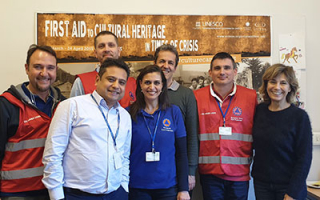Partners are essential for heritage conservation efforts, as collaboration can leverage various types of capital (e.g., financial, human, social, physical materials) for such activities as fundraising, management, research, education, and outreach. In disaster contexts, partnerships are needed to coordinate response efforts—and the importance of including cultural heritage conservation in response efforts is gaining more attention. In particular, ICCROM is increasingly viewed an important partner in both leveraging their network to access needed local expertise and training response workers in best management practices.
ICCROM, together with a range of institutional partners, has developed the “First Aid to Cultural Heritage in Times of Crises” (FAC) programme, a set of interconnected emergency response procedures leading to early recovery. FAC includes training courses and publications to safeguard heritage during emergency response.
During the week of 25 March 2019, ICCROM was invited to participate in an EU disaster response planning simulation exercise (MODEX 2019) that was contextualized around a scenario of extreme flooding in Florence, Italy. The simulation was coordinated by the International Search and Rescue Advisory Group (INSARAG) and Italian Civil Protection, as part of an effort to train teams in rapid, coordinated responses to disaster situations. Rohit Jigyasu, Programme Officer, ICCROM Regional Centre in Sharjah and an expert in disaster risk management for heritage properties, served as one of the institutional actors on behalf of ICCROM for coordination during the exercise.
Three teams, each mandated at strategic, tactical or operational levels, worked together to understand better how to coordinate with ICCROM during emergency response. Throughout the exercise, the team leaders expressed that although humanitarian efforts are their primary mission, this training exercise enhanced their awareness of their ability to facilitate first aid to heritage properties.
The exercise also included meetings with the Director of the Uffizi Gallery, located on the banks of the River Arno, and with Jigyasu at ICCROM. A few key areas for emergency response coordination included:
- using INSARAG’s network within the State experiencing the disaster to facilitate the necessary approvals for ICCROM’s request to assist in the disaster response efforts and, once approved, accessing restricted areas to begin heritage response efforts,
- using INSARAG’s external network of Member States to leverage financial resources and solicit specific equipment to facilitate first aid of cultural heritage (for stabilization, transport and storage of heritage fragments/objects),
- using INSARAG’s network of response workers to collect and upload photos of damage to cultural properties for ICCROM’s crowd sourcing efforts,
- using INSARAG’s mapping expertise to provide ICCROM with high resolution satellite maps to help ICCROM identify priority locations for response efforts,
- using ICCROM’s list of local heritage professionals for INSARAG’s consultation and response efforts, such as the packing of properties at the Uffizi Gallery (coordinated with other organizations such as UNESCO to avoid duplication),
- using ICCROM’s training courses and materials to train INSARAG responders to undertake damage assessment and in the handling of cultural properties,
- using ICCROM’s expertise to help INSARAG provide local emergency responders and volunteers in techniques for the proper handling of cultural properties.
The inclusion of ICCROM and the Uffizi Gallery as actors in this disaster response planning exercise provided INSARAG teams with appreciation of the need to rescue cultural properties in coordination with international cultural institutions such as ICCROM. Moreover, it provided ICCROM with an understanding of the role and functioning of INSARAG for coordinating cultural heritage first aid operations. Other INSARAG Member States are encouraged to include partnerships with ICCROM in future emergency response efforts to help safeguard cultural heritage.
Member States represented: Austria, Belgium, Estonia, Finland, France, Germany, Italy, Luxembourg, Netherlands, Norway, Poland, Romania, Slovakia, Sweden.

